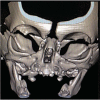Newborn nasal obstruction due to congenital nasal pyriform aperture stenosis
- PMID: 27103559
- PMCID: PMC4837133
- DOI: 10.2500/ar.2016.7.0146
Newborn nasal obstruction due to congenital nasal pyriform aperture stenosis
Abstract
Introduction: Nasal obstruction is an important condition that can lead to severe respiratory distress in newborns. There are several differential diagnoses, and one of them is congenital nasal pyriform aperture stenosis (CNPAS). CNPAS is a rare case of respiratory distress caused by excessive growth of the nasal process of the maxilla and leads to narrowing of the anterior third of the nasal cavity. Diagnosis, associated anomalies, and treatment strategies are reviewed by the following presentation of two cases.
Case presentation: We report two cases of infants diagnosed with CNPAS. The patients in the first case had no concomitant comorbidities, and the outcome was successful after surgical correction of stenosis. The patient in the second case had an associated holoprosencephaly, and although surgical correction and nasal cavity patency, the patient remains dependent on tracheostomy due to dysphagia and neurologic impairment.
Discussion: Airway obstruction affects 1 in 5000 children, and CNPAS is a diagnosis frequently forgotten and even unknown to neonatal and pediatric intensivists. Newborns are obligate nasal breathers, and, nasal obstruction, therefore, can lead to severe respiratory distress. CNPAS is not only rare but, many times, is not easily recognized. It is important to bear in mind the diagnostic criteria when evaluating infants with nasal obstruction. Conservative treatment should be prioritized, but surgical treatment is required in severe cases with failure to thrive and persistent respiratory distress. Respiratory distress and dysphagia may persist to some degree despite correction of the stenotic pyriform aperture due to associated narrowing of the entire nasal cavity and association with other anomalies. Final Comments: CNPAS is a rare condition and may be lethal in newborns. Differential diagnosis of nasal obstruction must be remembered to recognize this anomaly, and the otolaryngologist must be familiarized with this condition and its diagnosis. Precise surgical treatment in severe cases have high rates of success in children without other comorbidities.
Conflict of interest statement
The authors have no conflicts of interest to declare pertaining to this article
Figures







References
-
- Erdem T, Ozturan O, Erdem G, et al. Nasal pyriform aperture stenosis in adults. Am J Rhinol 18:57–62, 2004. - PubMed
-
- Wine TM, Dedhia K, Chi DH. Congenital nasal pyriform aperture stenosis: Is there a role for nasal dilation? JAMA Otolaryngol Head Neck Surg 140:352–356, 2014. - PubMed
-
- Reeves TD, Discolo CM, White DR. Nasal cavity dimensions in congenital pyriform aperture stenosis. Int J Pediatr Otorhinolaryngol 77:1830–1832, 2013. - PubMed
-
- Douglas B. The relief of vestibular nasal obstruction by partial resection of the nasal process of the superior maxilla. Plast Reconstr Surg 9:42–51, 1952. - PubMed
LinkOut - more resources
Full Text Sources
Other Literature Sources

